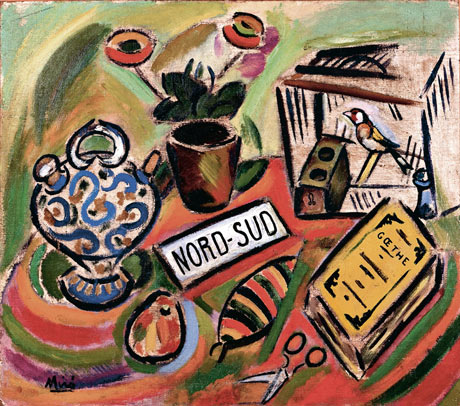Joan Mirò painted this intriguing composition in 1917, when he was 24 and dreaming about leaving his native Barcelona to pursue further art studies in Paris, the hub of all European artistic activity.
The war raging in Europe at the time forestalled any travel plans, and Mirò was obliged to stay put. The previous year, after completing his artistic education at the Accademia Galí and the Saint Lluc Art Circle, Mirò had rented a studio and had begun to rub shoulders with well-known artists. These are the fertile years in which Mirò discovered Fauvism and which lead to his first exhibition, in 1918.
"Nord-Sud" was a product of these years. In the picture, the words "Nord Sud" are centre stage. The words are sharp and bold, seemingly under a spotlight for the way in which they draw all the attention. What we are looking at, or rather reading, is the name of a newly founded publication created by Guillaume Apollinaire and a group of Parisian intellectuals and poets. Looking closely, it does appear to be a folded newspaper or magazine. The publication's promise of intellectual, artistic and physical freedom was doubtless a strong attraction for Mirò, hence the artistic emphasis, the bold lines, the contrasting bright white and strong black, making the words "Nord Sud" jump out at the onlooker.
The idea of freedom is further emphasised by the bird in a cage. Mirò feels caged, obliged to stay in Spain, but all the artistic promise of Paris beckons, to which he will fly at the first opportunity. The cage door is already open, all is ready. He will leave behind the everyday trappings of "artistically asphyxiating" Barcelona, represented by the homely objects (the flower-pot, the Catalan jug) on the table. The hefty volume in front of the bird-cage is by Goethe, no doubt underlining Joan's relationship with literature and his admiration for writers, although the proximity of the scissors in front of the book may indicate that Goethe is part of his old world that he is planning to cut away. The scissors are open, waiting, ready to cut the ties that bind him to Barcelona and to Spain.
Much later, in a 1936 interview, Mirò said "freedom has meaning for me ... " and his yearning for freedom is already evident in this 1917 painting. The strategically placed "Nord-Sud" magazine is all about freedom. Mirò's frustration and desire to break out is clear; he is feeling the need to enter a new artistic phase, maybe in a Goethe-like rite of passage, as his art comes to full maturity.
If we try to imagine the picture without the magazine in the centre, we have an interesting, colourful, vibrant still life (even with a live bird), but without the urgency and yearning that the presence of the intellectual journal implies. It is the Nord-Sud publication that represents freedom and crossing borders, and its position on the table, hemmed in by homely objects, means that Mirò saw an obstacle course with many restrictions ahead of him. He eventually made it from Sud to Nord: he got to Paris, finally to enjoy his well-earned artistic freedom, in 1920.




